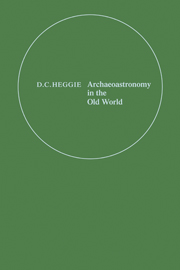Book contents
- Frontmatter
- Contents
- PREFACE
- LIST OF CONTRIBUTORS
- INVITED PAPERS
- CONTRIBUTED PAPERS
- A SURVEY OF THE BARBROOK STONE CIRCLES AND THEIR CLAIMED ASTRONOMICAL ALIGNMENTS
- OBSERVATIONS AT KINTRAW
- DECODING THE CALLANISH COMPLEX - A PROGRESS REPORT
- ASTRONOMY AND STONE ALIGNMENTS IN S.W. IRELAND
- STONE RINGS OF NORTHERN POLAND
- ASTRONOMICAL ORIENTATION OF NEOLITHIC SITES IN CENTRAL EUROPE
- STONE CIRCLE GEOMETRIES: AN INFORMATION THEORY APPROACH
- INVITED PAPER
- INDEX
STONE RINGS OF NORTHERN POLAND
Published online by Cambridge University Press: 05 November 2011
- Frontmatter
- Contents
- PREFACE
- LIST OF CONTRIBUTORS
- INVITED PAPERS
- CONTRIBUTED PAPERS
- A SURVEY OF THE BARBROOK STONE CIRCLES AND THEIR CLAIMED ASTRONOMICAL ALIGNMENTS
- OBSERVATIONS AT KINTRAW
- DECODING THE CALLANISH COMPLEX - A PROGRESS REPORT
- ASTRONOMY AND STONE ALIGNMENTS IN S.W. IRELAND
- STONE RINGS OF NORTHERN POLAND
- ASTRONOMICAL ORIENTATION OF NEOLITHIC SITES IN CENTRAL EUROPE
- STONE CIRCLE GEOMETRIES: AN INFORMATION THEORY APPROACH
- INVITED PAPER
- INDEX
Summary
Abstract. This paper is a preliminary account of field research carried out by the authors in June and October, 1980 and in May, 1981. The search was made for astronomical alignments at three sites. One such alignment has been found, and it is shown that Muller's results, previously thought to be correct, differ considerably from the actual situation. In conclusion some general remarks are made on the origin of the rings and their connections with the migrations of the Goths.
THE SITES
Węsiory (ϕ = 54° 13′. 3 N, λ = 17°51′. 0 E)
This site was first mentioned in 1938 (Petsch 1938), but was not excavated until the late 1950s (Kmieciński 1958–1968). It consists of 4 rings (2 of which are incomplete) and 20 barrows situated on the shores of a picturesque lake.
Odry (ϕ = 53° 54′. 0 N, λ = 17° 59′. 7 E)
The stone rings at Odry have been, very well known for more than 100 years. Therefore we do not want to repeat everything that has been written about them. All that we can state here is that this cemetrey consists of 10 rings and 27 burial barrows, but there are many more graves with no recognizable marking on the surface.
Odry is best known, of course, because of P. Stephan's (1914) astronomical theory and more recent work by R. Müller (1934, 1970), where it is pointed out that the structure of this site is oriented to the four cardinal points as well as to the solstices.
- Type
- Chapter
- Information
- Archaeoastronomy in the Old World , pp. 215 - 224Publisher: Cambridge University PressPrint publication year: 1982
- 2
- Cited by



